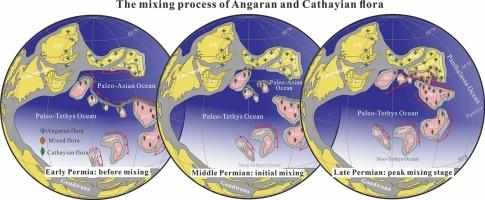古亚洲洋闭合期间的构造和古地理演化及其对生物圈的影响
IF 7.2
1区 地球科学
Q1 GEOSCIENCES, MULTIDISCIPLINARY
引用次数: 0
摘要
古亚洲洋闭合期间的构造-古地理过程对生物圈产生了重大影响,但人们对其了解甚少。形成于中二叠世的浙西组为海相沉积,而形成于晚二叠世的临西组为陆相沉积,标志着同时期的海陆过渡。这一构造过程强烈影响了生物圈的演化。在中二叠世期间,锡林浩特地块从古特提斯洋南部向古亚洲洋北部的运动破坏了两个体系之间的岩浆弧。这使得一股暖流从古特提斯洋流入古亚洲洋,导致海水温度升高,并在二叠纪中期导致适应冷水的腕足动物灭绝。在晚二叠纪,中亚造山带与华北克拉通的融合导致安加拉和华夏板块的混合,这两个板块之前分别被古亚洲洋的南北隔离。(1)古生代中亚造山带的持续向南增生,使安加拉植物区系的生境从高纬度寒区显著扩展到中纬度暖区;华北克拉通从赤道附近的热带和亚热带地区向北移动到中纬度温暖地区,使华夏植物区系适应了逐渐变冷的环境;这两个构造过程共同迫使原本不同的适应温度的物种随着时间的推移逐渐进化。最后,中亚造山带与华北克拉通的合并遵循“软碰撞”模式,没有产生大型山脉和古地理屏障,使安加拉和华夏植物区系得以混合。本文章由计算机程序翻译,如有差异,请以英文原文为准。

Tectonic and paleogeographic evolution during closure of the Paleo-Asian Ocean and their effects on biosphere
The tectono-paleogeographic processes that operated during the closing of the Paleo-Asian Ocean had a significant influence on the biosphere but poorly understood.The Zhesi Formation, which formed during the middle Permian, consists of marine facies strata, whereas the Linxi Formation, which accumulated in the late Permian, comprises terrestrial facies sediments, indicating a coeval marine-to-terrestrial transition. The biosphere evolution was strongly affected by this tectonics process. During the middle Permian, the movement of the Xilinhot Block from the southern Paleo-Tethys Ocean to the northern Paleo-Asian Ocean broke up the magmatic arcs that existed in the region between the two systems. This enabled the flow of a warm current from the Paleo-Tethys Ocean into the Paleo-Asian Ocean, causing an increase in the sea water temperature and the extinction of cold-water-acclimatized brachiopod fauna at middle Permian. During the late Permian, the amalgamation of the Central Asian Orogenic Belt and North China Craton led to the mixing of the Angara and Cathaysia realms, which previously isolated by Paleo-Asian Ocean to the north and south, respectively. Successfully mixing of the two species motivated by tectonic processes of i) The continuously southward accretion of the Central Asian Orogenic Belt during Paleozoic has significantly extended the habitat of the Angara flora from a high-latitude cold region to a mid-latitude warm region; ii) the northward movement of the North China Craton from tropics and subtropics regions near equator to a mid-latitude warm region has adapted the Cathaysia flora to gradually colder conditions; These two tectonic processes together forced originally distinct temperature acclimatized species evolved convergently through time. Finally, the amalgamation of the Central Asian Orogenic Belt and North China Craton was following a “soft collision” model that did not produce large mountains and Palaeogeographic barriers, which enabled the mixing of the Angara and Cathaysia floras.
求助全文
通过发布文献求助,成功后即可免费获取论文全文。
去求助
来源期刊

Gondwana Research
地学-地球科学综合
CiteScore
12.90
自引率
6.60%
发文量
298
审稿时长
65 days
期刊介绍:
Gondwana Research (GR) is an International Journal aimed to promote high quality research publications on all topics related to solid Earth, particularly with reference to the origin and evolution of continents, continental assemblies and their resources. GR is an "all earth science" journal with no restrictions on geological time, terrane or theme and covers a wide spectrum of topics in geosciences such as geology, geomorphology, palaeontology, structure, petrology, geochemistry, stable isotopes, geochronology, economic geology, exploration geology, engineering geology, geophysics, and environmental geology among other themes, and provides an appropriate forum to integrate studies from different disciplines and different terrains. In addition to regular articles and thematic issues, the journal invites high profile state-of-the-art reviews on thrust area topics for its column, ''GR FOCUS''. Focus articles include short biographies and photographs of the authors. Short articles (within ten printed pages) for rapid publication reporting important discoveries or innovative models of global interest will be considered under the category ''GR LETTERS''.
 求助内容:
求助内容: 应助结果提醒方式:
应助结果提醒方式:


